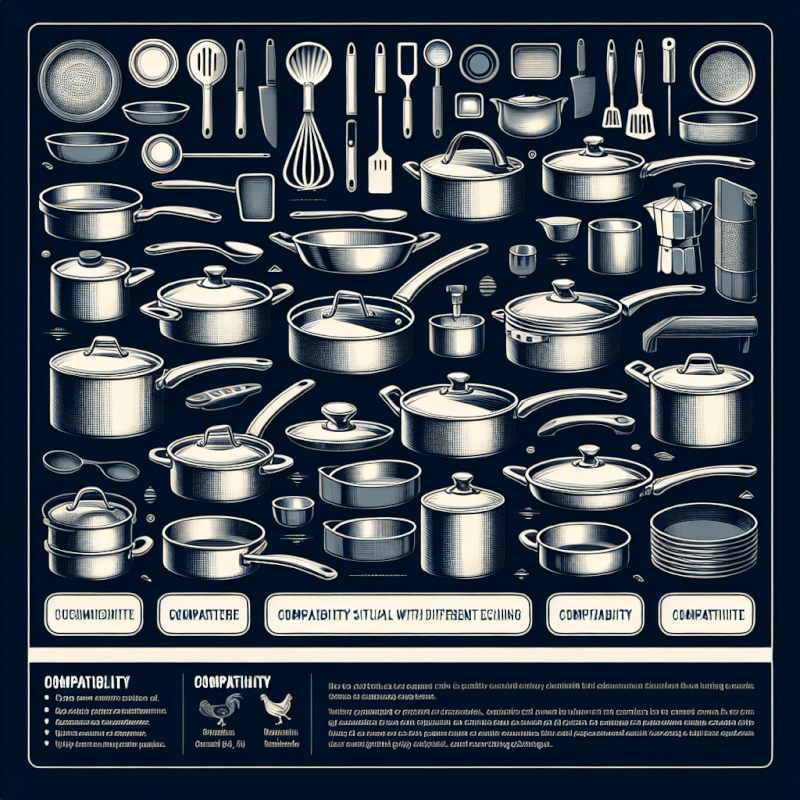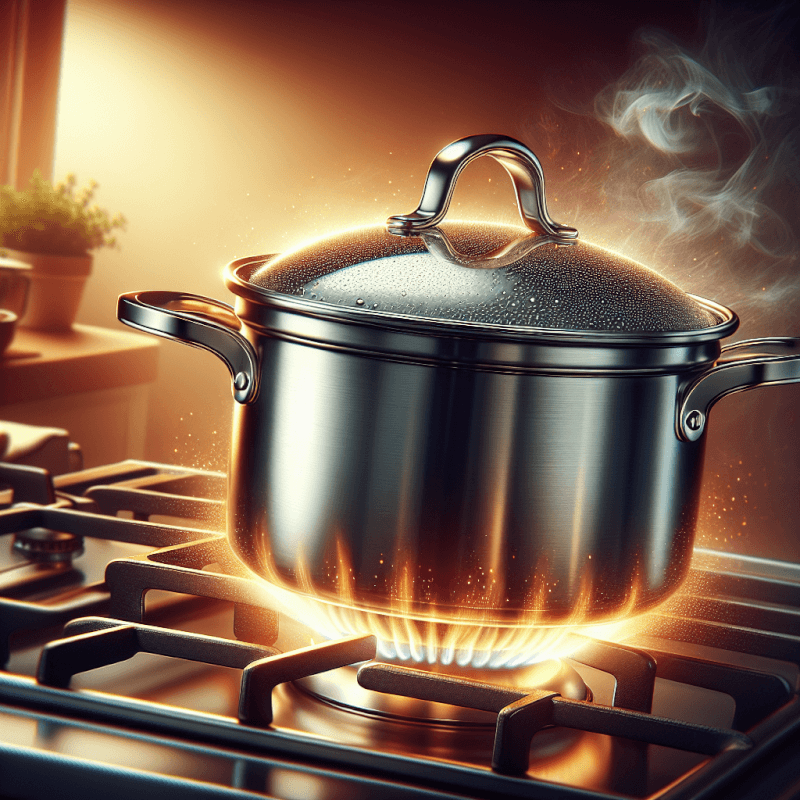When it comes to cooking, we all want the perfect balance between convenience and delicious results. But have you ever found yourself wondering if your cookware is suitable for a specific cooking method? It can be frustrating and time-consuming to experiment with different pots and pans, only to end up with disappointing outcomes. In this article, we will guide you through the process of determining whether your cookware is compatible with a particular cooking method, helping you save both time and effort in the kitchen.
Cookware Materials
When it comes to choosing the right cookware for your kitchen, there are numerous options available. Cookware is made from various materials, each with its own unique properties and advantages. Understanding the different cookware materials can help you make an informed decision and select the best option for your cooking needs. Here are some common cookware materials to consider:
Stainless Steel
Stainless steel cookware is a popular choice among home cooks and professional chefs alike. It is known for its durability, resistance to corrosion, and non-reactive surface. Stainless steel cookware is perfect for searing, browning, and sautéing. It can be used on any stovetop surface and is oven-safe.
Cast Iron
Cast iron cookware has been used for centuries and is renowned for its excellent heat retention and even heat distribution. It can withstand high cooking temperatures, making it ideal for slow cooking and deep-frying. Cast iron cookware requires special care and seasoning to maintain its non-stick surface and prevent rust.
Non-Stick
Non-stick cookware is coated with a layer of polytetrafluoroethylene (PTFE), which prevents food from sticking to the surface. This makes it easy to clean and requires less oil or fat for cooking. Non-stick cookware is great for delicate foods like eggs and pancakes. However, it is not suitable for high-temperature cooking or metal utensils, as it can release toxic fumes and scratch the coating.
Copper
Copper cookware is prized for its excellent heat conductivity, allowing for precise temperature control. It heats up quickly and cools down rapidly, making it perfect for delicate sauces and precise cooking techniques. However, copper is a reactive material and can leach into food, so it is often lined with stainless steel or tin to create a safe cooking surface.
Aluminum
Aluminum cookware is lightweight, affordable, and conducts heat evenly. It is an excellent heat conductor but can react with acidic or alkaline foods, altering their taste and color. To prevent this, most aluminum cookware is coated with a non-reactive layer such as stainless steel or anodized aluminum, which makes it safe for cooking a variety of dishes.
Glass
Glass cookware is a healthier alternative to plastic or metal containers for microwave cooking. It is heat-resistant, non-reactive, and allows you to see the food as it cooks. Glass cookware can also be used for baking in the oven, as it provides even heat distribution. However, it may not be suitable for stovetop cooking, as rapid temperature changes can cause it to shatter.
Cooking Methods
Now that you are familiar with the different cookware materials, let’s explore the various cooking methods and the type of cookware that works best for each technique:
Stovetop Cooking
Stovetop cooking refers to any cooking method performed on a stovetop surface, such as a gas, electric, or induction stovetop. The choice of cookware will depend on the type of stovetop you have and the cooking technique you wish to use.
Gas Stovetop
Gas stovetops provide instant and precise heat control, making them ideal for a wide range of cooking techniques. When using a gas stovetop, stainless steel, cast iron, and copper cookware are all suitable options. These materials can withstand high temperatures and distribute heat evenly, resulting in delicious meals.
Electric Stovetop
Electric stovetops take longer to heat up and may not offer the same level of control as gas stovetops. However, they can still produce excellent results when paired with the correct cookware. Flat-bottomed cookware with good heat conductivity, such as stainless steel or copper, is recommended for electric stovetops.
Induction Stovetop
Induction stovetops use electromagnetic fields to directly heat the cookware, making them highly efficient and responsive. For induction cooking, you will need cookware made from magnetic materials, such as stainless steel or cast iron. Non-magnetic cookware, such as aluminum or copper, will not work on induction stovetops unless they have an induction-compatible base.
Oven Cooking
Oven cooking involves baking, roasting, or broiling food in an oven. The heat in an oven is dry and indirect, so you need cookware that can withstand high temperatures and provide even heat distribution.
Baking
When baking, it is essential to use cookware that promotes even baking and browning. Aluminum or stainless steel baking pans are ideal for cakes, cookies, and bread. Glass baking dishes are also suitable, as they distribute heat evenly and allow you to monitor the baking process.
Roasting
For roasting meats and vegetables, a heavy-duty roasting pan made from stainless steel or cast iron is recommended. These materials retain heat well and allow for even browning. A roasting rack can also help elevate the food and allow air to circulate, resulting in a crispy exterior.
Broiling
Broiling requires cookware that can withstand high temperatures and be placed close to the heating element. A broiler pan or a cast iron skillet is perfect for broiling meat, fish, or vegetables. The ridges in the pan help collect and drain excess fat, resulting in healthier, flavorful dishes.
Grilling
Grilling is a popular cooking method that imparts a unique smoky flavor to food. Whether you prefer a gas grill, charcoal grill, or electric grill, choosing the right cookware can enhance your grilling experience.
Gas Grill
When using a gas grill, it is crucial to have sturdy and heat-resistant cookware. Stainless steel or cast iron grill pans are great for searing meats and vegetables. They retain heat well and create those coveted grill marks.
Charcoal Grill
Charcoal grills provide intense, direct heat, perfect for achieving that authentic grilled flavor. Cast iron grates are ideal for charcoal grills, as they retain heat and create beautiful sear marks. Cast iron skillets or grilling baskets are also great for cooking smaller items that may fall through the grates.
Electric Grill
Electric grills are convenient for indoor grilling, especially in apartments or homes without outdoor space. Non-stick grilling plates or stainless steel grill pans are suitable for electric grills. They provide even heat distribution and prevent food from sticking.
Microwave Cooking
Microwave cooking is quick and convenient, especially for reheating leftovers or cooking pre-packaged meals. However, not all cookware is safe to use in the microwave.
Microwave-Safe Cookware
Only use cookware that is specifically labeled as microwave-safe. This typically includes glass, ceramic, and microwave-safe plastics. Microwave-safe cookware allows the food to heat evenly and helps prevent damage to the cookware or microwave. Always check the manufacturer’s instructions before using any cookware in the microwave.
Induction Cooking
Induction cooking has gained popularity due to its energy efficiency and precise temperature control. However, it requires specific cookware that is compatible with induction cooktops.
Magnetic Cookware
Induction cooktops work by generating a magnetic field, which heats the cookware directly. To use induction cooking, your cookware must be made from a magnetic material, such as stainless steel or cast iron. Non-magnetic cookware, like aluminum or copper, will not work unless they have a magnetic base.
Slow Cooking
Slow cooking, also known as crockpot cooking, involves cooking food at low temperatures over a long period. It is a convenient and time-saving method, perfect for busy individuals or those who enjoy tender, flavorful dishes.
Slow Cooker
The slow cooker, also called a crockpot, is designed specifically for slow cooking. These appliances feature a low-temperature setting and allow you to cook food for several hours without supervision. Slow cookers usually have a ceramic or stoneware insert that provides even heat distribution and retains moisture, resulting in succulent meals.
Dutch Oven
A Dutch oven is a versatile piece of cookware that can be used for various cooking methods, including slow cooking. Made from either stainless steel or cast iron, a Dutch oven retains heat well and is perfect for cooking stews, braises, and soups on the stovetop or in the oven. Its heavy lid helps to lock in moisture, enhancing flavors during the slow cooking process.
Compatibility Factors
When selecting cookware, there are several factors to consider to ensure compatibility with your cooking methods and to achieve the best results.
Heat Conductivity
Different materials conduct heat at different rates. Cookware with good heat conductivity ensures even cooking and prevents hot spots. Materials like copper and aluminum excel in heat conductivity.
Heat Distribution
Even heat distribution is essential to avoid unevenly cooked or burnt food. Look for cookware that distributes heat uniformly across the cooking surface. Materials like stainless steel and cast iron are known for excellent heat distribution.
Heat Retention
Some cooking methods, such as searing or oven roasting, require cookware that retains heat well. Materials like cast iron and stainless steel excel in heat retention, ensuring consistent cooking temperatures.
Non-Reactive or Non-Stick Surface
For acidic or alkaline ingredients, it’s crucial to use cookware with a non-reactive surface. Stainless steel and glass are non-reactive materials, whereas copper or aluminum must be lined to prevent reactions with certain foods. Non-stick coatings can also be advantageous, reducing the need for excessive oil or butter and preventing food from sticking.
Safe Temperature Range
Some cooking methods, like broiling or high-temperature frying, require cookware that can withstand extremely high temperatures. Always check the manufacturer’s instructions to ensure that your cookware can handle the temperatures needed for your cooking techniques.
Tips for Choosing Cookware
Now that you have a better understanding of the cookware materials, cooking methods, and compatibility factors, here are some tips to help you choose the right cookware for your kitchen:
Research Cookware Materials
Take the time to research the different cookware materials and their pros and cons. Consider your cooking style, budget, and preferences to determine which material suits your needs best.
Consider the Cooking Method
Think about the cooking methods you frequently use in your kitchen and choose cookware that is compatible with those techniques. Consider the heat conductivity, distribution, and retention required for each method.
Check Cookware Labels
When purchasing cookware, read the labels carefully to ensure that it is suitable for your intended cooking methods. Look for terms like “oven-safe,” “induction-compatible,” and “microwave-safe” to ensure your cookware can withstand the specific cooking conditions.
Consult the Manufacturer
If you have any doubts or questions about the compatibility of your cookware with a particular cooking method, consult the manufacturer. They can provide you with specific guidance and instructions based on the cookware’s design and materials.
Read Customer Reviews
Customer reviews can provide valuable insights into the performance and durability of cookware. Consider reading reviews from other users who have used the cookware for similar cooking methods to get a better idea of its suitability.
Choosing the right cookware is essential for successful and enjoyable cooking experiences. By understanding the different cookware materials, their compatibility with cooking methods, and considering factors like heat conductivity and retention, you can find the perfect cookware that meets your needs. So, go ahead, explore the options, and equip your kitchen with the best cookware for your culinary adventures. Happy cooking!






